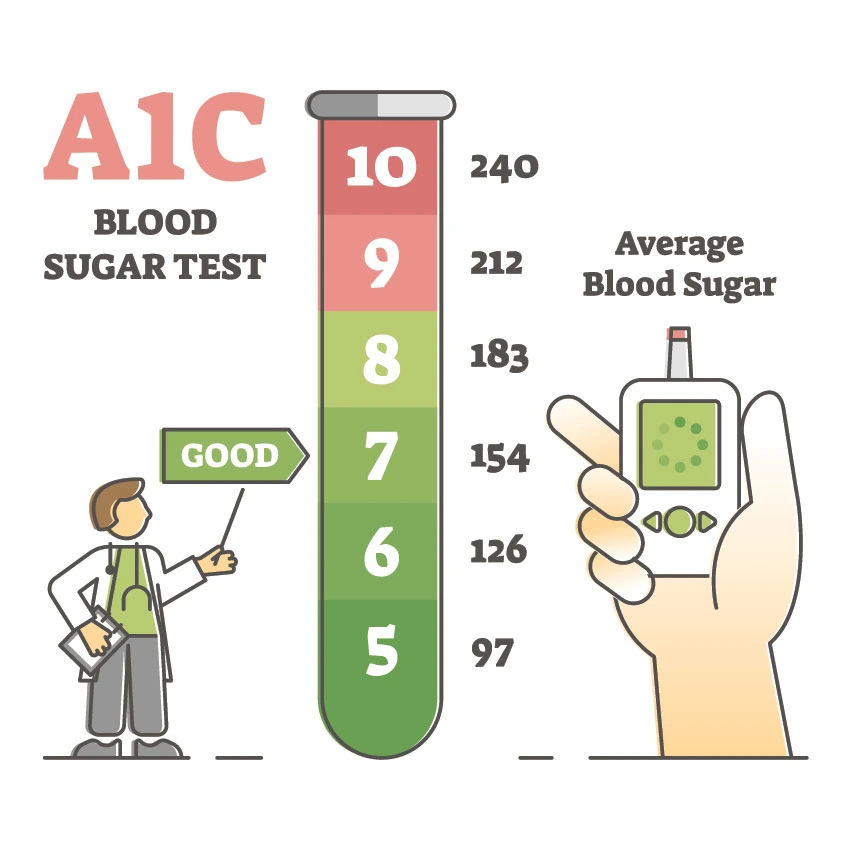Last updated on September 27th, 2022
An HbA1C blood test measures the average blood sugar level for the past 3 months or 90 days. The American Diabetes Association (ADA) recommends using A1C tests to diagnose prediabetes, type 1 diabetes, and type 2 diabetes.
Hb (Hemoglobin) is a protein found in RBC (red blood cells) whose role is to transport oxygen to cells. HbA1C is the portion of hemoglobin that takes up sugar in the blood. The high level may be a sign of poorly controlled diabetes.
The doctor relies on A1C tests to monitor diabetes treatment plans. If your ac1 levels are too high, this means your blood sugar is too high. Lowering blood sugar levels lowers a person’s A1C.

What is Glycated Hemoglobin?
Summary
Glycated hemoglobin is the part of hemoglobin that binds to glucose when the blood sugar level is high. Its level is a reflection of blood sugar levels throughout the lifespan of red blood cells.
Glycated hemoglobin is a biological parameter for monitoring glycemic balance in diabetic states (unstable, poorly balanced, insulin-dependent, or not).

What is an A1C test?
Summary
A doctor or nurse will do a blood test to determine a person’s A1C level whether it is good or bad a1c.
This test measures how well the body is holding blood sugar levels. It gives the average percentage of haemoglobin bound to sugar in a blood sample. When glucose gets into the blood, it binds to a protein in red blood cells called haemoglobin. Haemoglobin carries oxygen around the body:
- The higher the blood sugar, the more it binds to haemoglobin
- Red blood cells live for about four years. Months for the A1C results to reflect long-term blood sugar levels.
- In this test, the blood is taken from a finger prick or a blood sample.
- Doctors usually do more than one A1C test before making a diagnosis of diabetes.
- The first test helps a doctor determine a person’s baseline A1C for later comparison.
The frequency that a person diagnosed with diabetes should be tested depends on the type of diabetes and management factors.
Why Should You Reduce the A1C Values?
Summary
Many studies have suggested that lowering the A1C levels can help slow the progression of diabetes and reduce the risk of complications. Like nerve damage and cardiovascular disease in type I and type II diabetes. The American Diabetes Association recommends A1C for most people below 7%.
Many people ask what causes a1c to go up? The answer is the increase in sugar in the blood of a person. A doctor will diagnose diabetes when a person’s A1C is 6.5% or more on two separate occasions. Physical activity, diet, and possibly medication can help control blood sugar levels and thus also A1C levels.
Also Read: mmol to mg/dl conversion
Life Tips
Exercise and Style Tips To Lower A1C Levels Include:
Physical activity: Current guidelines recommend that adults use the 150-300 principal Minutes of moderate exercise every week. Individuals who take insulin should speak to their doctor about an appropriate pack.
Blood glucose monitoring: This is vital to ensure that the person is achieving their goals and making necessary changes.
Follow the treatment: This includes taking medication and lifestyle therapies.
Track progress: This is useful for self-motivation, monitoring change, and identifying the strategies that work for a person.
Involve others: Lifestyle Change it’s often easier to adapt when other people can encourage and monitor progress.
Nutrition tips: Monitoring of Carbohydrates can help a person control their blood sugar. General diet tips for lowering A1C levels include:
- Pay attention to the portion sizes
- Eat regularly, every 3 to 5 hours
- eat similarly small portions with meals and snacks
- plan meals in advance
- keep a nutrition, medication, and exercise diary
- Spread high-carbohydrate foods throughout the day
- ask a nutritionist for help
A doctor will advise each person on their dietary needs, including the number of carbohydrates they consume—this will lie on individual factors, including their training level and treatment plan.
Nourishment
Foods digested longer, like whole grains, have a slower and less impact on blood sugar levels. A person will digest them as simple sugars – found in candy and white bread – faster. This can cause blood sugar to rise. Frequent increases in blood sugar can accelerate the development of diabetes and increase the risk of complications.
Also Read: Normal Sugar Level in Body
Carbohydrates
A person with diabetes needs to control their carbohydrate intake, but they do not need to cut out carbohydrates altogether.
Tips for a Healthy Carbohydrate Intake
Spread the carbohydrates ingested over the day for reducing a1c through diet. Along with this choosing, the right carbohydrates is also an important aspect that must be considered when you have to work on lowering your A1C levels.
There are three types of carbohydrates:
Sugar: The body absorbs them quickly, causing blood sugar levels to rise.
Strength: They take longer to be absorbed and are less likely to cause glucose spikes
Fiber: This is essential for health. Its benefits include reducing the risk of hyperglycemia.
Fiber is complex and takes longer to break down, providing longer-lasting energy and the risk of blood sugar spikes. Fiber helps in properly Maintaining a Healthy Digestive Tract. If women consume at least 25 grams (g) of fiber per day and men 38 grams or more, the risk of developing type diabetes two can decrease. Around 20-30% Sources of fiber include whole grains, cereals, nuts, and whole fruits and vegetables. Whole fresh fruits contain more fiber than fresh fruit juices.
Natural sugar
Refined sugars such as candy are quickly absorbed by the body, leading to dangerous blood sugar spikes. Consuming fresh Fruits, vegetables, and low-fat-containing dairy products contain less processed sugar, which is healthier than refined sugar. All fruits and whole vegetables contain natural sugars, but they also tend to be high in other nutrients, including fiber.
Blood sugar is the level of sugar in the blood. It varies during the day but should be around 1g / L overall for an average rate. Eating meals and physical activity will make it evolve.
Also Read: How to Reduce Blood Sugar Level Immediately?
When Should the Blood Sugar Level Be Lowered?
Summary
In most cases, high blood sugar is detected at the time of the blood test result.
Blood sugar should be controlled as soon as it is over 1.10 g/L on an empty stomach. Initially, we will implement food hygiene measures – food balance and physical activity – and monthly monitoring as long as the parameters are not normalized.
Also, family tendencies or the presence of risk factors enhance vigilance. It is essential to control blood sugar when there are risk factors, such as being overweight, a genetic predisposition to diabetes high cholesterol level or triglyceride levels, or a history of cardiovascular disease.
Also Read: Long Term Complications of Diabetes
Foods to Lower A1C Levels
Summary
One of the main ways to lower your blood sugar is to monitor your diet without following a strict diet that can be a source of frustration.
It’s not about removing all the sugars from the dish. It’s about significantly reducing the quick sugars (sweets, chocolate, ice cream, sugary drinks, etc.) as well as saturated fats (cheese, sausage, stews in sauce, etc.)) fried food) ;
Reduce your consumption of alcohol, whose sugar penetrates the body very quickly;
Pay attention to the time of day when you consume carbohydrates. The body metabolizes sugars and fats during the night. Therefore, it is a question of limiting these contributions to dinner as much as possible. Energy expenditure decreases markedly with age;
Certain foods to lower hemoglobin a1c such as green tea or cinnamon are sometimes recommended to help lower blood sugar, but the effects are not miraculous;
Preference for fiber in the diet, which helps prevent a rise in blood sugar by affecting the rate of absorption of carbohydrates;
- Prefer foods with a low glycemic index (lentils, tomatoes, apples, etc.).
Can Physical Activity Help in Lowering A1C Levels?
Summary
There is nothing better to lower blood glucose level than to exercise regularly naturally. “From the first physical effort, the body will draw and consume carbohydrates, the fuel for the muscles.
However, twenty minutes of regular physical activity is enough to reduce a1c naturally and start with on condition that you sweat and exercise the cardiovascular system. You can then gradually increase the duration according to your physical capacities. Swimming, Nordic walking, running, cycling, aerobics. So many activities to favor. The correct frequency? 2 to 3 sessions per week.
These sessions are in addition to the WHO recommendations, which are to walk about 30 minutes each day. Everyone’s physical abilities must, of course, be respected. The important thing is to practice a regular activity and within the limits of your means to not endanger your health and for lowering a1c levels quickly.
If gentle gymnastics or weight training can benefit flexibility or sheathing, however, be aware that they do not affect blood sugar. So favor cardio sessions.
Also Read: Reverse your Pre Diabetes Naturally
FAQs:
How fast does metformin lower A1C?
Using metformin can help reduce the level of A1C in the body. However, it takes at least a minimum of one week to show results. To reduce the level of A1C doctors often prescribe lower dosages of metformin to patients and increase it gradually.
How is glycated hemoglobin determined?
Glycated hemoglobin is obtained by taking a blood sample on an anticoagulant (heparin, EDTA), usually at the elbow bend. The assay can also be performed from a drop of blood obtained by pricking the fingertip.
Why prescribe a dosage of glycated hemoglobin?
Glycated hemoglobin assay is prescribed to monitor blood sugar levels in people with diabetes. This test checks the control of diabetes over the past two months. HbA1C helps visualize the average concentration of glucose in the blood over this period. With this dosage, the doctor will be able to see whether the treatment taken by the patient to control his diabetes is working or not.
Who needs this test?
Glycated hemoglobin testing is suggested for checking blood sugar restriction in people who may be pre-diabetic and controlling blood sugar control in patients with more lofty levels, termed diabetes mellitus. Diabetes being the major reason for causes of high a1c levels. Hba1c level well below 7 designates an appropriate authority on diabetes, and hence it’s suggested to take HbA1c test every three months for better monitoring.
How is HbA1c performed?
Many people ask the question how does a1c get calculated? Numerous techniques are used to estimate Haemoglobin A1c. Laboratories use high-performance liquid chromatography (the HbA1c outcome is calculated as a ratio to total hemoglobin using an enzymatic assay, immunoassay, capillary electrophoresis, or boronate affinity chromatography.
References:
- https://www.healthline.com/health/diabetes/ways-to-lower-your-a1c-level
- https://www.everydayhealth.com/type-2-diabetes/treatment/ways-lower-your-a1c/
Last Updated on by Dr. Damanjit Duggal
Disclaimer
This site provides educational content; however, it is not a substitute for professional medical guidance. Readers should consult their healthcare professional for personalised guidance. We work hard to provide accurate and helpful information. Your well-being is important to us, and we value your feedback. To learn more, visit our editorial policy page for details on our content guidelines and the content creation process.

 English
English














